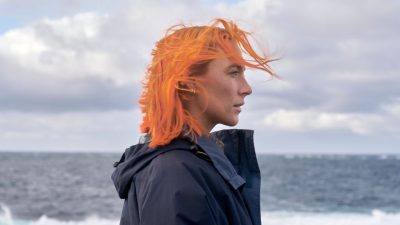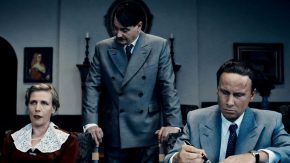My house is my body. Sometimes an eternal labyrinth.
A chaotic bustle. Lots of reflexions.
Toss and turn – where I stand, without even starting off.
A way, an obscure collision in the darkness, a connection.
Synchronicity.Body is in the focus of the show ’My house’, body with different attributes. Body, collecting, mirroring and remembering information. A camera lens, sometimes objective, sometimes subjective.
My home is my castle. My body is my channel.
On the stage – regarding our respective abilities, with movements, words, pictures – we create a common „watching” space. Here, the borders of the physical are sharpened, individuals are caught in maze, our uniqueness and struggles become apparent.

(c) Csaba Mészáros
If you search for the production ’My house’ on the Hungarian Trafó House of Contemporary Arts, you find this description. Before the premiere on May 7, I asked choreographer Andrea Mészöly for further details.
Drawing a parallel between human body and a house or a home is just as old as humanity itself. How will your show reflect on this? What can you as artists add to this ancient topic?
I’m a member of Artman Society since 2011. This is a contemporary performance art group where disabled and healthy artists work together in different projects and spaces. Shows made like this, just like mine, cooperate with someone who is somehow different from we „healthy ones”. Born with different foundations, living their lives differently, but clearly equivalent to us. Csaba Bruckner, with whom I’m already working for the second time, is a disabled person with quite restricted ways of communication.
Still, it’s not like me picking up people for my dance show. Everyone is here because they want to, because it’s important for them for some reason. For example to create art, express emotions, get attention. For Csaba Bruckner, being on stage and acting are parts of his life.
There are three male artists in the production, getting closer to the main topic from three completely different ways. One of them is Tamás Bakó, contemporary dancer, who feels comfortable in his body on a large scale, which is like having lots of colourful rooms in his house. The other is Csaba Bruckner, a disabled man with a unique home, with strange boundaries and special codes. And the third one is László Kövesdi, an actor who forms body through situations, stories, making it comfortable or uninhabitable.
We started to reflect together on the parallel of the human body and houses/homes, and we additionally raised questions about what is convenient for us in a situation. What makes the body stretched, overstrained, uncomfortable? How does tension transform to anger, helplessness or indifference. What are our own blocks, barriers? Where are unique lines, overlapping, what is collective?
We connected different art forms in the space through improvisation (dance, texts) and pictures (animations). This is how we created this show.

(c) Csaba Mészáros
Who organized the production and how did this group of artists get together?
I’m the axis and the topic of the production. I have a recurring dream where I’m roaming around in a house. I always discover new rooms, but somehow I am already aware of them before going in for the first time. During the last three years, I was a member of a group where we work with improvisation
and body-consciousness techniques on ourselves and with each other. We also discuss our experiences there. For me, the basic experience is how our body senses us and our environment from our birth on, and how it saves our stories.
I haven’t worked with all members of this certain group, but I have some relationship to all of them: previous works, friendship, acquaintance. I’m connected to the artists a bit closer, though. With László Kövesdi and Csaba Bruckner, it’s our second work together, and I played with Tamás Bakó in another show. We speak the same language when being in the rehearsal room and experiencing. And this is my first time to work with Gergő Bényi and Bazil Duliskovich.
Watching the trailer, this show is a quite minimalistic one. Why is it so? What is the concept behind the choreography?
Thinking about minimalism, I associate words like commence, basics, skeletonizing with it. Something free from unnecessary things. In the beginning of our work, it wasn’t clear whether we have any expectations at all regarding the pictures or the music, whether we want a minimalist show or not. This is how we shaped it together, or more like this is what is showed about itself.
Humans and artists live in a certain frame. Time, possibilities, money are all our external realities. These components write and shape the production, too. Now we managed to create something from our external and internal realities.
You were the only woman in the group – all the artists, the music editor, the photographer, the animator and the lightning technician are all men. How did the work go, how did it feel to conduct so many people (men)?
Yes, it’s strange. Originally, we planned to do with a female lightning technician, but she didn’t have time in the end. There was also a photograph taken by a woman that we didn’t use in the final version, so now all photo credits go to Csaba Mészáros. It was a challenge to undertake myself in such a situation, but I think it succeeded.
I was sure about the male artist. Yes, it’s also a kind of minimalism, because if there are men and women on stage, then there are already roles, social situations. I was much more interested in the individual, in originality and seeking ways in the framework of ’my body, my house’.
As a woman myself, I know a lot about female situations, roles. But I don’t know as much about male ones, so this work was an intriguing experience for me, also from this perspective.
How do you use the poet János Pilinszky’s poem in your production?
A short film is also part of our show, made together with Csaba Bruckner. Our aim was to let he external reality come to the stage, and to show a process throughout the film, a bridge that brought us to the production. What happens on stage in real time is the internal reality of each of the actors, where all their vulnerabilities are expressed and redeemed.
This process is depicted very well in János Pilinszky’s poem Weedy. You can feel the insecurity and helplessness of loneliness on the one hand, and its majestic flying on the other.
János Pilinszky: Weedy
There is grass. Day and night.
Yesterday someone told me, ’come,
come here’, and so I did
walking on the weedy ground.At night I’m scared. But mornings
warm me up and float me,
even if I’m lying wordless and motionless.My clothes are soft and familiar.
But without clothes
I feel cold and tiny.If someone leads me, I can walk firmly.
If alone, I feel insecure.
Still at times like this I almost fly,
even if scared of getting lost in the grass.



























Comments